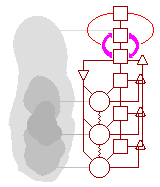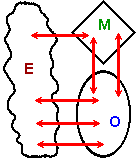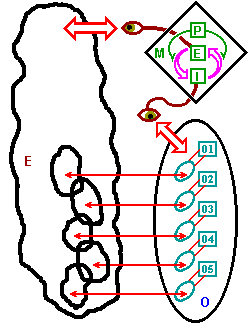Introduction Preface Section 0: Cybernetic Eyes Section 1: The Quick Guide to the VSM Section 2: Case Studies Hebden Water Milling 1985 Triangle Wholefoods 1986 One Mondragon Co-operative 1991 Section 3: Preliminary Diagnosis Janus interlude Section 4: Designing Autonomy Section 5: The Internal Balance Section 6: Information Systems Section 7: Balance with the Environment Section 8: Policy Systems Section 9: The Whole System Section 10: Application to Federations Bibliography Links Appendix 1: Levels of Recursion Appendix 2: Variety  This work is licensed under a Creative Commons Attribution-NonCommercial-ShareAlike 4.0 International License. |
Section 1: THE QUICK GUIDE TO THE VSM
Quick Guide: The ModelThe Viable Systems Model looks at an organisation interacting with its environment. The organisation is viewed as two parts: the Operation which does all the basic work (production, distribution, earning the money) and the bits which provide a service to the Operation by ensuring the whole organisations works together in an integrated way (scheduling, accounts, strategic planning ...) These bits are called the Metasystem. The following diagram illustrates the basic VSM.
The Operation will consist of a number of Operational units. These could be production units or teams of people doing various jobs. The Metasystem can be divided in three main functions:
This is the basic model: The VSM sees any viable system as a collection of Operational elements which are held together by a Metasystem. Both Operation and Metasystem must be in contact with, and interacting with, their environment. The Operational units themselves must be viable, and thus can be looked at as smaller Viable Systems embedded in the larger system. Quick Guide: The Model - Slightly Elaborated
Quick Guide: Preliminary DiagnosisIn the Preliminary Diagnosis you look at your own organisation and examine the units which compose it. That is, you list the bits that do things, the co-ordination functions, the accounting and scheduling functions and so on. You then draw a large VSM which will look something like the pictures on the previous pages to identify:
At the end of this process, you will have a large picture which gives a representation of your organisation in its totality. This is the basic model from which the rest of the diagnosis will follow. In some cases the Preliminary Diagnosis will be the most useful aspect. You may find that your organisation has no way to carry out some of the functions which are vital for viability. Thus, you may decide to create new jobs to ensure these functions get perfomed. You may also find that some jobs don't seem to have anything to do with the Viable Systems. You may decide they are not necessary. Quick Guide: Designing AutonomyIt is essential to create the right conditions for all the Operational units to function with as much autonomy as possible. Thus they will need
There will also have to be safeguards to ensure that the units cannot threaten the overall viability of the organisation of which they are a part. Thus
Quick Guide: Balancing the Internal EnvironmentBy this stage you will have looked at the various parts of you organisation and decided how they map onto the VSM. You will also have considered the autonomy of the Operational units. The Internal Environment consists of all the Operational units and those jobs which are dedicated to looking at them (The Internal Eye) and to ensuring that conflicts are resolved and that their performance is optimised. Internal balance is concerned with these (Metasystemic) jobs and with ensuring that they have the capabilities to function properly. So for example, a committee which meets once every three months would be an absurd idea - most of these jobs need to be done on a continuous basis. The approach to Internal balance is as follows:
The essence of the internal balance is to view the Inside of your enterprise as a system of autonomous Operational elements, which need to be overseen (the Internal Eye) to look for ways of generating synergy. The imposition of dictates from above should only be used when the viability of the whole enterprise is at risk and not, as in traditional businesses, as the usual way of dealing with most problems. Quick Guide: Information SystemsThe VSM requires thorough and up-to-date information systems. The perfect information system would measure everything it needs to know continuously, so that a real-time model of the goings on within any part of the enterprise may be maintained. The compromise between this and the usual management information which is weeks or months out of date is the use of daily performance indicators. These measure whatever is seen as important within each Operational units (productivity, morale, wastage, sales, breakages ...) at the end of each day. The figures are then plotted onto a time series so that the trends may be assessed. The essence of the VSM approach to information is that you only need to know if something changes. If everything is going as normal, you can leave it alone. However as soon as something changes (dramatic fall in productivity) it's essential you are notified immediately. Thus:
These signals, which are called algedonics, are the basis of information handling in the VSM. They can be designed to provide Operational units with the information they need to learn and adapt to environmental changes, to define clear limits to autonomy, to guarantee that each Operational unit is working as an integrated part of the whole-system and so on. The design of these information systems is crucial to the effective operation of your enterprise, and can be used as an alternative to authority. Quick Guide: Balance with the EnvironmentThe External Eye maintains contact with the relevant parts of the external environment, and enables the future planning systems to develop strategies for adapting to change in the market, or to new technology, or whatever. Again, the various parts must be balanced:
Quick Guide: Policy SystemsThe policy systems oversee the entire organisation. They constitute the ultimate authority. Clearly they must be designed with great care. For a co-operative it is crucial that everyone is involved in policy decisions and this usually involves a meeting of all members. However, the practicalities of this need to be addressed. How often can the entire membership meet? How effective are big meetings? The answer to the question of how you involve all members in policy decisions and how you ensure that everyone has to work within these ground rules is perhaps one of the biggest questions for any Social Economy enterprise, and will determine the extent to which it may describe itself as democratic. Quick Guide: Basic VocabularyThis Quick Guide to how the VSM looks at organisations and how it ensures the various parts are balanced has introduced most of the basic vocabulary.
From now on, the manual will assume you understand these terms. It will also use the five systems to describe the various functions within the organisation.
|
|||||||||||||||||||


